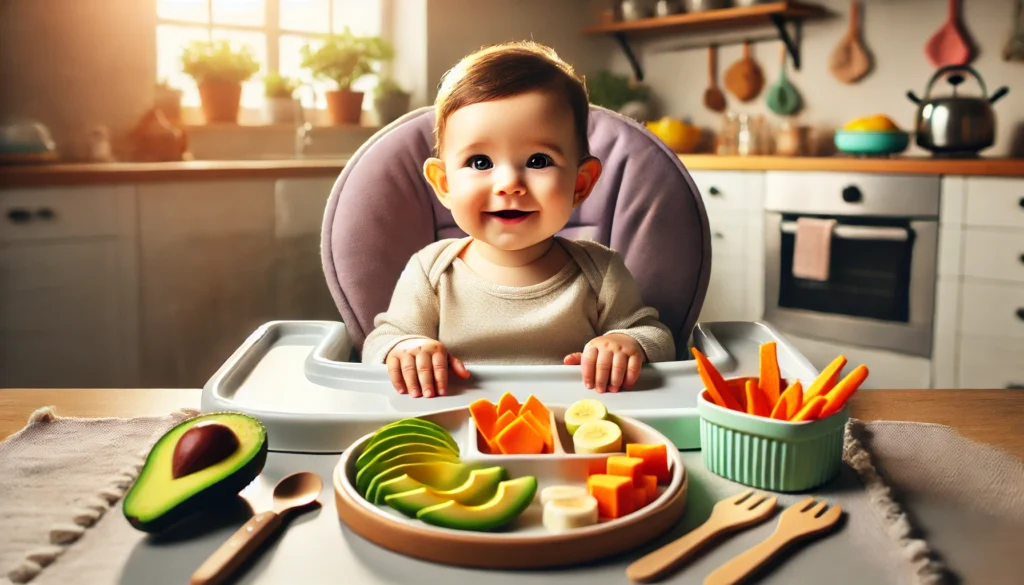
Introducing solid foods to baby is a significant milestone that lays the foundation for healthy eating habits. This journey from exclusive breastfeeding or formula feeding to incorporating solid foods into your baby’s diet is often referred to as weaning.
Here’s a comprehensive step-by-step guide to help new parents navigate this exciting phase of introducing solids to baby with confidence.
Step 1: Recognising Readiness for Starting Solids
Before you embark on baby-led weaning journey, it’s crucial to ensure your baby is ready for solids. Most babies show signs of readiness around 6 months of age, but it’s important to look for these key indicators:
- Ability to sit up with minimal support.
- Good head and neck control.
- Showing interest in food, such as looking at what you’re eating.
- Opening their mouth or leaning forward when food is offered.
- The ability to reject food by turning their head away.
Step 2: Preparing for the First Feed
Choose a time when your baby is not too tired or hungry. You might want to offer a little breast milk or formula first, so they’re not too hungry to be patient with this new experience. Equip yourself with the right tools—a small, soft-tipped spoon, a bib, and a high chair that supports your baby in an upright position.
Step 3: Choosing the First Foods for Starting Solids
Iron-rich foods are a great choice for your baby’s first solid food. Options include:
- Pureed meats and legumes.
- Soft cooked and finely mashed vegetables and fruits.
- Check our Meal Guides Section for suggestions.
The goal is to introduce your baby to a variety of tastes and textures, not to replace breast milk or formula feeding.
Step 4: How to Start Introducing Solids
If you are feeding the baby, start introducing solids to baby with a small amount of food on the tip of a soft spoon. Allow your baby to smell and taste the food, and don’t be surprised if the first few attempts end up everywhere but in their mouth! This is a learning experience of starting baby on solids.
Step 5: Establishing a Routine
Gradually, you can start to establish a feeding routine, offering solids once a day and slowly increasing as your baby shows interest and appetite. It’s important to continue breastfeeding or formula feeding, as it remains your baby’s primary source of nutrition until their first birthday.
Step 6: Advancing Textures and Varieties
As your baby becomes more comfortable with eating, you can start to introduce a wider variety of foods and textures. Move from pureed to mashed by 7 months, then to finely chopped foods by 9 months, offering a balanced diet that includes fruits, vegetables, grains, and protein sources.
Step 7: Encouraging Self-feeding
By around 8 months, many babies show interest in self-feeding. Offering finger foods that your baby can pick up and explore can help develop their fine motor skills and independence. Always supervise your baby during meals to ensure safety.
Step 8: Watching for Allergies
Introduce allergenic foods like peanuts, eggs, and dairy products one at a time, in small quantities, and watch for any signs of an allergic reaction. Early introduction of these foods can help reduce the risk of developing food allergies.
When do Babies Start Eating Solids
Babies typically start showing signs of readiness for solids around 6 months of age. However, it’s essential to look for specific indicators to ensure they’re truly ready. Key signs include the ability to sit up with minimal support, good head and neck control, interest in food (like watching you eat), and physical cues such as opening their mouth or leaning forward when food is offered. Each baby is unique, so watch for these developmental signs to know when your little one is prepared to begin their journey with starting solid foods confidently.
Conclusion
Introducing solids to your baby is an exciting milestone that supports their growth and development while laying the foundation for a lifetime of healthy eating habits. By recognizing readiness cues, selecting nutritious first foods, and encouraging safe self-feeding, you can help your baby embrace new tastes and textures at their own pace. Remember, every baby is unique, so enjoy each moment of this journey, knowing you’re nurturing your child’s curiosity and independence with each bite.
Know your guide

Hello, amazing parents! I’m Riddhi Verma Ayyagari, a Stanford-certified Child Nutritionist and Baby-Led Weaning Expert. With years of experience and a proven approach, I’ve helped 8000+ of families navigate child nutrition, from starting solids to tackling picky eating.
Make mealtimes easier and more enjoyable with personalized 1:1 Sessions and my expert-led MasterClass. Start your journey to stress-free feeding today!
